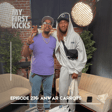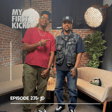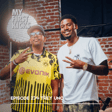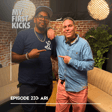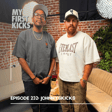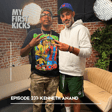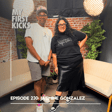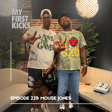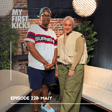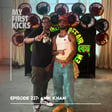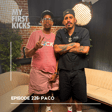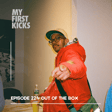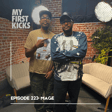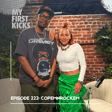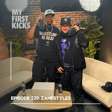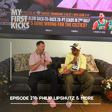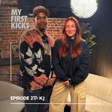Become a Creator today!Start creating today - Share your story with the world!
Start for free
00:00:00
00:00:01

The Blueprint of Footwear Architects with Mathew Drazic
This week I am joined by Mathew Drazic, we talk about his journey into designing sneakers. Working on the Converse All Star Rodman, also his time at New Balance. How he found his way into sneaker design. Also how he fell in love with sneakers at a young age. Working within the sneaker industry and what led him to starting his own company. How he wants to make an impact in this world and much much more!
Where to find Mathew & Agency Footwear:
IG: https://www.instagram.com/agencyfootwear/
Website: https://agencyfootwear.com/
Podcast Linktree: https://linktr.ee/myfirstkicks
Music by The DoppleGangaz: https://thedoppelgangaz.bandcamp.com/
Recommended
Transcript
Introduction and Sneaker Event
00:00:15
Speaker
What's good, everyone? Welcome back to My First Kicks. This is episode 201. And this week, I bring to you my guest, Matthew Drowsick. Welcome to the podcast, man. Thank you very much, man. It's very good to like meet up, finally make this happen.
00:00:30
Speaker
No, yeah. I mean, shout out Marcus, shout out Sean for putting this together. OSD, you know, the I mean, Marcus is not my OG, but Sean is my OG, you know, just like he always gives me game. And, um you know, we met at the Extra Butter conversation um with the sneaker release for your new company agency. And It was just very insightful. Even though I only caught 100% with you, I only caught maybe 10 minutes of the conversation because the Mets were playing. And I went to the bar next door to watch the game. So I was i was just like, it's the playoffs. I'm like, look, go have like I told Marcus, I'm like, you're going to you you're gonna have to give me some leeway over here. like I'm here for you guys, but I'm also here for the Mets.
Mets Game vs Sneaker Discussion
00:01:11
Speaker
like That particular day I do actually remember that that Mets game was a big deal. Yeah, it was a I think it was a wild card game and they were like ah try Yes, it was a wild card game and then they hit a home run to actually advance and it was like the last like the ninth inning and we were like me and Shout out Dookie who works extra butter as well. We were like we we're like, oh my god screaming at the end and there was so high but yeah that I mean the The conversation I did catch was very insightful, and but I'm also glad I didn't catch the whole thing because now I get to ask you all the questions I wanted to ask you after learning about the project. So yeah. Right on. Yeah, let's go. I'm ready.
Matthew's Career in Footwear Design
00:01:56
Speaker
Yeah. ah So before we jump into that, how about you introduce yourself? Let everybody know where you're from and then you know a little bit about agency.
00:02:04
Speaker
Sure. My name is Matthew Drasek. I am a footwear designer from Seattle and I've been doing this for over 25 years. um Started out with interning at Converse and then working at New Balance, working for Diesel. Then I kind of went on a path where I i've followed my heart a little bit more than following my career.
00:02:27
Speaker
which has its own ups and downs. um And so, so that's basically it, you know, it was just I've been a shoe designer my whole entire career straight out of school, actually left school early in order to do it. um Had a kid on the way at the time, so it was kind of like I had to. um But I was able to turn it into a career in. And now I'm i'm going out on my own.
00:02:53
Speaker
I mean, that's absolutely fire. Can't wait to hear more about your
First Footwear Memory
00:02:56
Speaker
story. ah So let's start off with the first question. And that question is the question that I ask everybody each week. And that question is, wow, I said question like six time there. But that question is, what's your first case? Was that first person because you absolutely needed to have?
00:03:10
Speaker
Yeah, man, so so it was actually a soccer shoe. It was the Made in West Germany, Kangaroo Leather, Adidas, Copa Mundial. Wow, okay. And um because the Made in West Germany ones were a big deal at that time. And um and also like childcare for my family when I was young was me on the side of the soccer field at my siblings' soccer practice. Yeah. So soccer was a big deal.
00:03:37
Speaker
um And also, like back then, it also it was reading catalogs. I was reading a ton of catalogs. I was a little dyslexic. So I would easily read through the bullet points. And back then, it was before East Bay. It was before we had anything going on that we have now. But it was that they actually broke down what shoes were in the soccer catalogs.
00:04:00
Speaker
Yeah. It was like, here's the leather, here's how much it weighs. here Here's, you know, whether the outsole is made out of polyurethane, whether cleats are replaceable. It's where I learned what PBACS was, all that stuff. But when it comes to the actual sneakers, it's funny, because i got ah I just got a picture of me in these shoes from my dad over the holidays.
Nike Air Trainer Nostalgia
00:04:21
Speaker
But it's the Nike Air Trainer. Nice. one So the John McEnroe shoe. I didn't know it was ah John McEnroe at the time. That was not why I was in him. But yeah, it was those shoes. I wore the crap out of those shoes. I wore them to the point where the outsole was worn through, air bubble pop, they were squeaking. I mean, my dad, i'm if I remember correctly, my dad threw them out the window of the car one day when he was just like, I can't handle it anymore. um and That's how long I wore those shoes. but i
00:04:54
Speaker
Did you play any tennis at all? though Or you you were just like, these were just my shoes? No. So like I said, I grew up playing soccer, but then I was getting into other sports, you know, learning basketball, volleyball for me, um but learning a little bit more about football and all that stuff. And so it was kind of like junior high. We're talking 88 way back before retros even were a thing. And um and so cross training actually meant something to me. It was like,
00:05:24
Speaker
It was new. Cross training was new. The idea of exercising in that way for multiple sports was new. And um and also shoes were... at a really cool precipice of going from the cup sole of the original Jordan, right, to the molded outsole of the Jordan II. And so it was right around that same time is when this came out. And, you know, i I love basketball, but, you know, had to shout out the SuperSonics with Peyton and Kemp back when they were going against Jordan, right? Yes, sir. They were so good. but i Did you get to get did you get to see them play live like did you did your dad take you to a game? No, we didn't I was we didn't have the money for that no i mean look and you never know I mean, I don't know cuz like usually out here, you know, you get to if you're lucky right or and if the team stinks bad enough you you get your school will be like yo, we can go to a game like what I said, that's how I became a Mets fan like
00:06:25
Speaker
Well, I remember being in public school and then being like, hey, ah we're going to be ah we're going to be doing a Mets game on such and such day. Make sure you get this on your paper, your paper sign. And we'd go there and you know, you bring you a little 10 bucks and you get a little little Pepsi and a hot dog and you're good to go. But that yeah, that that that's like that. I don't know if that is for everybody, though. You know, yeah I don't know if you get that chance, you know.
00:06:50
Speaker
You know, i went to I went to a lot of professional sports games, but they were um like indoor soccer or um or minor league soccer, basically. It was before there was a real pro league in the States and before before like the Cosmos had Pele and and yeah all that stuff. The Sounders did have a team back then. ah So I did go to a game in the Kingdom. Do you remember the Kingdom? Yeah. um But yeah, basketball, I did watch Every single game in college is like I think it was the 92 season. It was 92 games or 96 games. And it was the year we made it to the finals against Jordan. Oh, yeah. um Yeah, so we obviously didn't win. But at the same time, it was it was that group of college buddies and me. It was every single game we even like turn the volume down on the TV and put up the turn the radio up in front of the TV. so we could get the local sportscaster. It was Kevin Calabro who then you know went on to ESPN and became bigger things. but yeah so that was That was a big thing.
00:07:56
Speaker
um but it made me think like Your question, the first shoe that I had to have, like yeah the first Air Trainer one was cool and I wore it out and it like sparked that thing in me. But at the same time, the one that I had to have went out of my way to go find was the Nike Air Trainer SC2, which is the one that had like neon green, neon like lime green oversized tongue on the top.
00:08:25
Speaker
How much I have to look these up because I've never heard. Yeah, you'll recognize it. You'll recognize it for sure. S.C. two. Yep. Yeah, I was right around. Oh, yeah. yeah um these uh they gave uh Calvin Johnson has the Transformers in these okay okay yeah they retroed them in that so yeah yeah i love those shoes and but it was you know that's when i was like on the eighth grade basketball team i was not a good at i was not varsity basketball
00:08:59
Speaker
but And maybe that's because I wore cross trainers to play. my um You're out there in tennis shoes playing basketball. I just had to have that lime green tongue top, man. It meant something. And it kind of makes me think, because I ah designed an oversized tongue on the shoes on agency footwear too. So it was like, maybe that's where that came from, just to have that. um But that's also kind of like when style was kicking off in that sense in sneaker style. Um, so it was just always, always in there for me, always in, always in my brain,
Passion for Shoe Design
00:09:37
Speaker
like from when it actually physically started. Yeah. the Very curious about like how sneakers translated, especially back then. Like how did, cause you know, we, everybody complains of like,
00:09:51
Speaker
Where sneakers originated from a sneaker culture originated from but it's like the one thing we don't really get is the actual insight on other states states and how they receive sneakers because we know about the through line of like hip hop to sneakers and drug dealers and you know people getting money and all this stuff but like yeah I mean, yeah did you grow up in Seattle? like Yeah, I was in Kent, Washington, which is about 30 meters south of Seattle, working class suburb. Nobody knows where it is. But yeah, out there, you know,
00:10:26
Speaker
It was, it was, I didn't understand like the I-95 corridor. I didn't understand Air Force Ones. Like none of that hit me. None of that was around for me. And I grew up in a surprisingly multicultural ah like area because it was working class. yeah Um, you know, and because it was a suburb, it was kind of like where everybody could live that was close to the city. Um, and so.
00:10:52
Speaker
Yeah, it was it was it was different. It it was just more like sneak. It was just there wasn't even a sneaker shop nearby. Right. Like you had to go to the mall if you're going to get that. um And then, you know, maybe there was a footlocker or I don't even think Champs was around at that time. You know, it was a foot action, probably. That was it. No athletes foot.
00:11:16
Speaker
Maybe athletes foot. Yeah, yeah, but that's not about it Yeah the so like were you making these journeys out to them all here and there or was it just like like how did you find out? The next shoe you wanted to get like how did you find out about the SC2? It's like catalogs. Okay That was like the East Bay days, you know, and um and that's that's kind of how we found out about everything. You know, whether it was a soccer cleats or whether it was whether it was track shoes, you know, anything that was specialty for a high school. It's kind of like how it came to us was almost like these are the shoes you should wear for your high school sports.
00:11:53
Speaker
Yeah, and so yeah, and so then well you took that and then also wore them just relentlessly too. You weren't just wearing them on the court, right? Like what what was that like reception? Like was everybody doing that? Was that like, oh, yo, I got these new shoes. Like were you guys showing off shoes back then?
00:12:14
Speaker
I mean, so I feel like with the air trainer SC2 is the one with the neon tongue. Um, I feel like those actually got noticed. Like those were something different. The first ones that John McEnroe's not as much.
00:12:30
Speaker
They were, you know, white and gray with a little bit of black. They didn't pop the same way. um And, you know, it wasn't like I was one of the cool kids. I was somewhere in between an art nerd. Yeah, I was like an art nerd in kind of, but I played soccer and I was actually pretty good at it. So I was, but soccer wasn't one of the main sports in high school yeah until, well, it was actually in high school. It was kind of close for, but that's where we were. We were in a suburb where soccer was one of the main sports in high school, right? Yeah. So it wasn't like you guys got a lot of land out there. Yeah, exactly. You know, exactly. A lot of land and that's a sport you can play in any weather. So it's just like, yeah. And, you know, that I love soccer. I mean, I'm half Brazilian, so I love soccer. When you when you mentioned the shoe, I mean, well, you mentioned the the Mundial. I was already like thinking Pele. And then when you mentioned Pele, I was like, yeah, you know, like Cosmo era Pele, he was always wearing those. And and I think they didn't they do they drop their shoe commemorating him or something like He had the Puma King. So he was the Puma King, which is basically the same shoe. Yeah. yeah I mean, they all took the same model. Yeah. The difference for him was it had that huge oversized tongue, actually. Again, common thread here. But, you know, it was this white.
00:13:45
Speaker
kind of flack floppy tongue that flapped around. And we did that with the Copas too, you know, you had to fold them over and it had to flap it had to cover the laces. You know, and part of the reason you got the West German ones because they had a little bit of blue on the label. And so you could tell yours were different. And they were like, you got that special edition, you're like, you're like, you don't got this blue on here, man.
00:14:10
Speaker
from headquarters, you know, because there's maybe West Germany, it meant something. So like, you know, as a progression goes on, like, where where does it, where does sneakers really like, or kicks really just like take, like, get a get a bite out of you, where you're just like, Oh, I'm really interested in this.
00:14:26
Speaker
I mean it was then i was i was even told reminded at one of my high school reunions like um one of my friends said i remember you sketching sneakers in your notes like in history class or in whatever class And, um you know, I would like I said, I was kind of in I was an art nerd, but at the same time, you know, they weren't like great drawings or shoes or anything like that. um But there was definitely an interest and it started there. And I worked with my art teacher. um My art teacher was the only black teacher in our high school, by the way. He was also my soccer coach. um And we're still friends to this day. And he. That's awesome.
Industrial Design Education
00:15:07
Speaker
Yeah, he's the one who pointed me he's the one who pointed me in the direction of industrial design because I wanted to do shoes, because he knew I could draw. um And that was kind of a thing, because we you know he like I said, he was my soccer coach, and i would we would go over the catalogs together. And I didn't know what industrial design was at the time. I'm not 100% certain he did either, but he figured it out.
00:15:31
Speaker
He figured it out and he found that path and that was what led me into college and I actually did an independent study ah course in my industrial design courses at university to to do shoe design.
00:15:46
Speaker
That's awesome. and Like, I mean, I also feel like and I'm very curious because, you know, we mean we've seen where it is now and how it is a lot easier to get into. But like, what was it like first and how hard was it to find something? Because, you know, you said you did a little bit of research and, you know, I also feel like around this time, it's not necessarily like everybody wants to do it. Everybody's like, you're either gonna be a doctor or, you know, like the, ve like, I was gonna say veterinarian. and I don't even think veterinarians are really that popular back then. But but the but progression of of just like, for example, I mean, I'm just gonna say my example was I always wanted to design video games. There was never a real course of like, hey, these are the things to do to become a video game designer. It was like, you do computer science. And then after that, you figure it out after that.
00:16:37
Speaker
um And then when I finally got into college, ah then there was other colleges being like, hey, we got a video game design course. And it's like, now you've streamlined this thing that people before us have just been trying to figure out a way to push like everything together and take the electives to make it to make it work into one thing that actually results in you becoming a video game designer. But like as a footwear designer, what was that for you?
00:17:02
Speaker
There was no pathway in the States, you know back then and I've only learned this retroactively back then there was Specific footwear design schools in Europe, but they were all traditional shoes, you know It was all kind of leather-based out of Italy or Spain or Portugal maybe England and then um For us it came through product design in shoe design I mean, the reason Tinker Hatfield ah was a designer was because he was an architect. yeah you know His story is famous now. But there he wasn't like a designer. Most of the, or a footwear a-specific shoe designer, there was no such thing as pencil. um And and um so I thought I wanted to be an architect, not knowing who Tinker was really at that time.
00:17:49
Speaker
um and you know my high school was one of those that had ah a lot of vocational opportunities so one of the things that i did was i catered my senior year was i did uh two two hours of graphic design and i drove to another high school in our school district and did two hours of architecture Then I drove back to my high school and did my required social studies in English. Wow. That was my vacation ah was my whole senior year, right? Yeah. So I mean, I was learning how to do drafting, um you know, from early, early on. And um not only that, but I took like a separate drafting class, all that stuff. I was almost like.
00:18:33
Speaker
learning how to take my artistic abilities and monetize them. Yeah. Turn them into a career. And so I just didn't know what I wanted that to be. And thankfully, my school had a situation where you could look up a profession, go into the library, and you could learn like how many people were graduating with that profession or with that degree per year and how many jobs were available in that profession per year.
00:19:00
Speaker
And I learned that architecture was a saturated field. There were more architects graduating than there were architect jobs available. And so I was like, I got to figure something else out. And that's when, that's when my teacher and I figured out, um, shout out to Glenn Walrin. Hopefully he sees this. Um, yeah. Uh, that's when, that's when, um,
00:19:20
Speaker
you know And that's when we figured it out. and so But that was also, I wasn't 100% shoe design at that point in time. I was car design because cars are cool. oh yeah And and that the school that I ended up going to had a really good car program, not design based, but engineering based. So they worked on like hybrid race cars and um and they they came in like third or fifth in the global solar challenge in the world. Yeah.
00:19:54
Speaker
which is crazy for a ah school of like 10,000, 15,000 kids called Western Washington University, almost in Canada, on the water in Washington state, you know, and nobody outside ye nobody else knows the Vikings, nobody else ah outside of the state really knows what Western is.
00:20:13
Speaker
yeah right So um they batted a little bit above their weight class or punched above their weight class. And it was a good school, but it was small. you know And it was only you know only moderately known in the region. But they had a technical-based industrial design program. yeah And so it was learning how to render. And it was all product design. you know Big thing that we would draw all the time was hair dryers.
00:20:38
Speaker
vacuums, you know, anything that you molded. um And then also the classes were like you had to take you had to take woodworking, plastic, metals, everything. And now they have like, oh, um they have materials for designers. Yeah, one similar how you were talking, like now they have one class streamline for the design program, versus you had to just take everything. Yeah, you know, I'm pretty sure you're like, you're like you son of a gun. I remember i remember um looking through the i don't know syllabus course, whatever it was. um yeah was like It was 180 credits to graduate with an industrial design degree, which is why it took most people five years. And then it was 90 credits to graduate with a degree in psychology. Yeah.
00:21:25
Speaker
And I literally double. a Double. and And I was like, this is insane. um yeah're You're out here, you're you're like looking at like you're your therapist and just being like, you know, I went to school twice as much as you. Right? And then she'll be like, yeah, but I had to get a master's. Yeah, no, it it was crazy. But they like I said, they've streamlined it now. Yeah. um and But it was it was was great. I was going to say, but you said you didn't finish college. I didn't. So the way that our school worked was you kind of got out all your prerequisites ahead of time.
Converse Internship and Career Shift
00:22:00
Speaker
um And then and then you applied to the industrial design course. and Only 12 people per year were accepted into the industrial design. Yeah. um And so then.
00:22:10
Speaker
And that's because the classes were like four hours long um and they were all like studio classes. You learned how to build, you were making models on your own, you were doing full-size drawings of vehicles and stuff like that. So just things that took up space and took a long time.
00:22:29
Speaker
yeah um and So in my sophomore year, I applied for industrial design. I was one of the 12 people that got accepted into the program. And in between my sophomore and junior year, I went on an internship to Converse, which is all the way across the country in Boston.
00:22:49
Speaker
Um, and you know, I mean, this is a little bit of my personal history, but it was, it was one of, it was a moment where my ex-girlfriend and I were kind of like, we were, I knew I was moving. And, and so we called each other on the, we talked on the phone and was like, Hey, I got something to tell you. Oh, I got something to tell you. And I was like, I'm moving. And she was like, I'm pregnant. Oh.
00:23:12
Speaker
Yeah. yeah ah so So for me, my career, like that's when I was like, I did the internship and I was like, I got to turn this into a job. I can't afford to keep paying my way through college you know if there's a kid coming. And so um thankfully,
00:23:31
Speaker
at that internship at Converse, I realized, and just through being there, that it doesn't matter your background. If you can draw a shoe, you put it up on the wall next to the other drawings of shoes. yeah And it doesn't matter if the person ah who drew the shoe next to yours has a master's degree or went to RISD or went to CCS, you know all the big schools. um If your shoe fit Like pardon the pun there, but like if you draw something good that people like, then then it gets accepted. yeah And so I was able to just kind of force my way into into a career that way. What was the shoe?
00:24:14
Speaker
what was the shue You know, I didn't get any shoes of my own design when I was an intern. That would be a pretty difficult thing. That would be crazy. That would be like, so I made the React juice, and here we are. Right? But as an intern, because I had all that drafting background, which I learned was fairly uncommon for people my age,
00:24:38
Speaker
um I was able to do the blueprints for some senior designers. you know And and you know some of them, they went to more of an art-based design school, and so they weren't necessarily really into doing blueprints. And one of the blueprints that I worked on was the first dedicated Rodman shoe for Converse. o um yeah this is that one of yeah yeah This is the one that, based on his tattoo ah the collar, right? So like they put the Chuck Taylor logo inside his tattoo, the spiral sun tattoo. Yeah, I remember that. Yeah. And that the reason that shoe became really known was because he I think he was wearing it when he did that famous photo of him laying out, where he's like in a full-on Superman pose in midair, yeah chasing the ball out of bounds.
Understanding Sneaker Design Blueprints
00:25:28
Speaker
This is the Converse All-Star Rodman.
00:25:31
Speaker
Yeah, so I did the blueprint for that as an intern. Wow. These shoes were crazy as always. Yeah, they were. It was a tough, it was actually a tough blueprint period. Yeah. Yeah, was it was but it was cool. It was, you know, and the guy who designed it, um he was trying to, you know, he was trying to break new ground with different things. Yeah. And um so yeah, it was it was definitely a great experience.
00:25:58
Speaker
That's awesome. the Especially even getting the chance to do it. And I don't know what entails, what goes into creating the sneaker blueprint, but I know, you know, I've seen like pictures from like when ah Peter Moore like has the dunk out and he has that like, it looks like a blueprint and it has all the like lines of like, what ah this is what's gonna be what? And this is gonna have air unit and all that stuff. So it's very interesting because That is something you do not hear or see about. It's like if you know, you know type of thing. And it's like, especially back in like the 90s, 2000, it's all just like speculative. And you're just like, it works though. Like you're just like, the shoe works. you
00:26:42
Speaker
Yeah, but I mean, like, the SR-71 Blackbird is still famous plane to this day. It was drawn by hand on a drafting table. It's one of the last ones before they got CAD and before they got computers and that. But, you know, so that's that's that era. But Functionally until very recently, ah design, you still had to do a blueprint before somebody else did 3D, right? Or before you went and did your 3D. And so it would be like, here's the bottom here's the bottom view, here's the side view, here's the other side view, here's the top view, here's the front view, here's the back view.
00:27:18
Speaker
And then, you know, the the kind of the areas in between, you know, those angles ah where everything kind of comes together, that's where a little bit of the magic happens in the mold process. And, you know, people at every the engineers that are putting that together have to kind of understand and and make that work.
00:27:39
Speaker
Um, so that was the only part that was a little bit off, but I mean, we were measuring everything down to a millimeter. We were using multiple pencils. You know, you had different thicknesses on your pencils yeah and, um, just to highlight each thing you do in all the cross sections. So.
00:27:57
Speaker
And that was the thing, excuse me. So it was like, you'd also do a cross section for the forefoot, the arch, the heel, and then you do one called the AA down the middle from toe to heel. Yeah. And that's you know still to this day. If you do that, you can get a shoe made, period. That's crazy. that I mean, look, everybody listening, this is how you do it. You're getting the, ah what is it? The, but no. the What's the term, what's the phrase I'm looking for? this the the chicken in the soup or something. I don't know. I'm trying to remember the phrase. It's going to come to me eventually. I'm going to I'm going to remember it. But so like from there, how did how were you able to like like did that start to like expand your love for sneakers, especially working within it? Like because I know, you know.
00:28:46
Speaker
everybody like wow Everybody dreams like I'm gonna get this job and then eventually you're just like I hate this job so you know you you literally will this into existence and then you turn it into an actual thing because your back was against the wall so like what at what point like you know they did it become like a love or like did you want to grow more in it?
00:29:07
Speaker
It was always there. When I figured out that that's what I wanted to do with my art teacher, it just made perfect sense. It was like, right, this is my purpose. I can draw, I can do the drafting, and I've always loved shoes. I was always that guy. I always wore the weird eclectic one, whatever happened. Were you still collecting also?
00:29:31
Speaker
Oh yeah, this is, I mean, when you finally get in a real job and making money, that's when I finally really got into collecting and um then I could buy whatever, but also I'm a size nine, I'm a sample size. o So from the time I was intern,
00:29:47
Speaker
people would buy, whatever they would buy, competitive samples, yeah I would go run. like Like I said, I wasn't great at basketball, but I was good enough to like get some stuff done. yeah And I could, you know one of the things, I only dunked a volleyball in college. like That's my thing. Never got, I could palm the basketball. um But you know it was like, I was decent for a six foot and under player, right? So um we would go run and we would test out the shoes and you know and we would see what we were up against and and it was all prototypes you know i had tons of prototypes that nobody else had because i was a sample size, um you know and so then it kind of became special in yeah.
00:30:26
Speaker
And um yeah, it was it it's a great, great corporate job. I can't ah can't underline that enough. you know when Ultimately, once you get kind of established, you know you're not junior designer, so it goes intern, junior designer, associate designer, designer one, designer two, senior designer, lead designer, director of design, vice president of design. So by the time you're like just a designer one,
00:30:56
Speaker
you're taking inspiration trips. You go for like five days or a week to wherever. Sometimes that shows up by your boss, but if you're, you know, sometimes you have the autonomy to choose it for yourself and you're,
00:31:10
Speaker
For some companies, they just go so they just go shoe shopping and they just see what's in the market in other places, and they call that inspiration. But when you're at one of the bigger companies, you're doing a deep dive into whether it's culture or people who are playing like you know this is an elite high school basketball um team and like get to know them, or you're just going to like a going to Italy, going to Japan.
00:31:35
Speaker
and just kind of getting the flavor of different things to to put into your shoes. And um one trip we took, we we kept it local and we went to like air races and stuff like that and stock car races and just kind of got into the background of that. So you get to take inspiration trips, you get to travel the world for trade shows.
00:31:56
Speaker
Um, and for factory work, you know, factory work isn't the most glamorous, but yeah it does fill up a passport and you do get to see, uh, you do get to see and learn about different cultures. And it all just depends on how open you are and how willing you are to kind of like embrace that. So, um, great, great corporate job as far as, as far as I can see. I have no a different perspective on it now. But yeah, yeah you're selling me is all let's say about to start looking it now the so like yeah you you're drawn for a living. That's this other thing. Yeah, like it's your job to draw. Yeah, which is I feel like that puts you puts a lot of pressure on on that. Like do you did you feel a lot of pressure?
00:32:40
Speaker
I'm one of those people who likes pressure. OK. You're a diamond. You know, it's kind of forged by fire, right? You know, if you're born into a situation that's a little bit rougher than normal, you kind of come out a little bit more polished sometimes. Maybe you're still rough around the edges, but when it comes time to shine, you can. And so yeah, I liked the pressure. I liked the competition. It was friendly competition, for the most part.
00:33:09
Speaker
They're still the the biggest challenge for most designers in the beginning of their career is their own ego. Yeah. And it's letting go of the shoes and and when I say letting go of the shoes, I mean like they're they feel like your baby, they feel like your creation. and And you shepherd them through the process and you know maybe you convince vice presidents and presidents to be able to adopt your shoe and your shoe gets put in an international marketing campaign. and you know And that feels really cool. Like your parents get to see it and people, you know you run into people and be like, I designed those. And that feels really good. But you know it it's it's still,
00:33:52
Speaker
not your shoe. right You're not designing for you, you're designing for a company. in And the sooner a designer can come to that realization and just kind of like let it be, then then it's easier to accept like when a a novice merchandiser comes through and they're like,
00:34:13
Speaker
And you've been designing shoes for however long. just Even if it's three, five years, whatever, yeah you know to have somebody who's new to the category be like, oh, I think this needs to be different because this retailer said X, Y, and Z. And then a salesperson says, well, that shoe sold better. So it needs to be more like that shoe. And you know they just kind of turn it into a widget yeah instead of a biomechanical solution.
00:34:37
Speaker
um You know, it it that's what you have to let go of. That's the hard part, is is is that. Yeah, ah very curious because now you I just thought about this question where it's just, you know, you're you're in behind the scenes, but you're also partaking, like you are, you know,
00:34:57
Speaker
You're on the East Coast now, right?
Innovations at New Balance
00:34:59
Speaker
like you're You're just starting to see where all this stuff starts bubbling up and all these sneakers again bought out and people are realizing that there's a sneaker culture. But like were you able to partake? Were you able to see the both both sides and see how they can influence each other and help you out?
00:35:21
Speaker
Yeah, you know, it was interesting. So my first job after converse was with Rika. And Rika is for women by women, which doesn't make sense that I would work there. But I was just a junior designer. Yeah, I was working under four different powerhouse women that all came from Nike and Adidas. And that was when Michael Rubin, the Michael Rubin of today, like he was just in his 20s. And this is one of his early companies. And he he bought like, I think we had three, I actually did.
00:35:51
Speaker
I did Carl Malone's Apex. Wow. Apex signature sneaker. Yeah. Now, if you can find that online, let me know because I have a hard time finding that one. I'm going to see right now. Yeah, Carl Malone, Apex sneaker. I mean, that was, I was in my 23 maybe, early 20s, maybe 22. Got it right here. Shout out to the, it's got the mailman 32 on the side.
00:36:17
Speaker
I'd have to see it. I'd have to see it. It had a huge, huge VA sidewall that went way up and way up and way up. Yeah. I'm going to send it to you right now. OK. Yeah, so that was just because Michael Rubin owned Apex. He owned a hiking brand and he owned Rika. And then we were in Pennsylvania is where it was based. And so, yeah, that's the one.
00:36:46
Speaker
yeah Shout out sneaker history. Nick Eggvall. He did a whole write up on it. I mean, I wish I would have known I would have reached out. But yeah, that was how was me back in the day.
00:37:00
Speaker
um These are sick. I mean i like these. They are what they are, right? He was he liked a really high top shoe. yeah you know he was ah He was a big dude. He needed a lot of stability, so that's why we went with the EVA so high. um Kept it flexible, but you know it was... ah can't remember what year that was, what we got in 97, 98. So 96, 97. Okay, yeah, so we would have been working on that in 90, 90. Yeah, right around there. My daughter was born in 97. So that makes sense. um And
00:37:39
Speaker
I mean, you just took me down memory lane. I got i gotta to get out of this so that I can actually concentrate. um Yeah, so so I went and worked with Raika. And what that taught me was, it was tiny, right? it was it it was It was sold from the founder. And Michael bought it. And then um and then Nike and Adidas women took it over. And it was like,
00:38:06
Speaker
this really, really cool opportunity for them to have a voice outside of Nike and Adidas, and they could shape a bunch of shoes for women. Yeah. and um And we were super streamlined. I think we had seven people in the office. Wow. And you know as the senior designer, I was a junior designer, so I did all the blueprints for her, designed a couple of shoes for them, but not too many. And then um And then we had the vice president, the marketing person and the CEO. And then um one sales guy and one ah marketing assistant. That's it. That was a whole team in Portland um because Michael Rubin had the headquarters in Philadelphia. So like HR and back into the house was was over there. Yeah. um
00:38:49
Speaker
But then he sold it. So he sold it to Avia or American sporting goods at the time. And that was because he changed models to go online, which is obviously smart and obviously helped him become what he is today. um And so at the time,
00:39:06
Speaker
I took the opportunity to to get a payout. I was like, oh, I can get i can get a severance out of this and and not do anything. oh That's cool. and I was still working my way out of debt um at the time. and so um so Then after that, I got a job at Converse. and Converse was like kind of gets into your question of like behind the scenes and getting to see what it's like.
00:39:30
Speaker
So you left Converse to come back to Converse? I mean, sorry, I meant New Balance. new balance there you are right yeah Converse internship, right under Michael Rubin, and then New Balance in Boston. in um Yeah, you know, that was super, super interesting. You know, at the time, they kind of referred to it as as a footwear university. Yeah. Because they did technically, they did everything right. I mean, we were working with carbon fiber in the 2000s. You know, it was on shoes that were mainly like stability shoes.
00:40:09
Speaker
Um, you know, the, the overbuilt running shoes of the time yeah that were for pronation control that they don't even really make those anymore. right Um, excuse me. And then, and then my category was cross training and tennis. And, um, so I would work on.
00:40:26
Speaker
the shoes that eventually inspired the Nike Monarch. Wow. Nike Monarch, right? It's just this white leather shoe, kind of a dad shoe. But that was inspired by the cross training and tennis series from it New Balance. There was like the 801, 2, 3, 4, and 5. I did the 805 and 806, I think. um And I actually saw that like they've they're either retroing some of them, but some of them still exist. And so,
00:40:57
Speaker
I had such an interesting conversation at that time. So we were trying to do new things, because they kept trying to get into Foot Locker. They couldn't really break through into Foot Locker. And and one of the things that we would talk about is like, we don't want to try and out Nike Nike, because that's the direction they were pushing us in, like create you know these these shoes that are kind of like Basically the TR, the trainer or the TR runner, TR Air. TR runner. The one that they kind of just retroed right now. It's like the Air Max TR. Is it the? It's the one that they only sold at Footlocker is the one that I'm thinking of. That is Tuned Air.
00:41:36
Speaker
Yes, two in the air. Yeah, yeah the TN. TN, my bad. And I was like, we can't out Nike. Nike, we just need to build a better new balance. That was kind of like my saying internally. And I had this conversation with one of the vice presidents who was telling me how important the the white leather ah tennis shoes were in cross-stream shoes were for new balance.
00:42:00
Speaker
And, but internally, they called them barbecue shoes or butt crack shoes. Yeah. You know, they were, they didn't really, like, that's when I kind of learned that the consumer, the the people weren't people, people were consumers and consumers were a target to, to check off, you know? And that's why one of the things about Nike's logo is like a check mark. Like they got you.
00:42:24
Speaker
They got you to buy their shit. you know And that's what the swoosh is on on on people. and so um And so I just remember having the conversation where I was like, it's not that hard to design a shoe that's already been designed and just update it. Yeah.
00:42:40
Speaker
you know And just kind of do, it's very formulaic. And I was like, an intern can do that. It's really hard to actually design a ah ah new category for a brand. um And so we tried really hard to to start new categories within cross-training. One of the things that didn't work was ah a versatility series where it was like a all general purpose shoe.
00:43:05
Speaker
um It was kind of on and off road. You could wear it, dress it up, dress it down, sort of thing. That one didn't work. But one that did work was because those white leather training shoes were and were our tennis shoes, we actually um broke through on on actual performance tennis. Wow. And lightweight tennis. And so the eight, I think it was the 820, New Balance 820, CT, New Balance CT820. Yeah, CT for court.
00:43:34
Speaker
um That one won Editor's Choice in Tennis Magazine, and it was our first lightweight on-court performance you'd made for the ATP level, tour level professional tennis player. um And I was able to do that one, and that that worked out well. That was right when i left new right around when I left New Balance. Before that, we did some overbuilt tennis shoes called the 1001, 1002, or 2001, 2002. I can't remember.
00:44:06
Speaker
But um they're kind of like these on court performance shoes where we put all of our technology in there. And it's interesting because I'm sure other companies have these conversations. But the big technology for us was called Absorb SBS. Yeah. Right. That's still a thing. That's still a thing. Yeah. Because i have the ah I only have one pair of New Balance and it's still on there. So it's like, yeah.
00:44:32
Speaker
Right, and that's that's kind of when we were doing it, but Absorb SBS was because New Balance was a running shoe company, or is a running shoe company, and they're fighting ASICs for market share, and ASICs has ASICs gel, and Brooks had their own form of gel before they went to DNA. and um and abs Absorb, it it was nice, it cushioned or Absorb SBS, ah but it was heavy. It made the shoes heavy and all they wanted was a visual display but that the technology was in there. So what we would do is we would we would build like a side wall of the of the abs Absorb SBS and then a really thin underneath the bottom of the shoe that was cored out even. So it was like worthless.
00:45:16
Speaker
Cushioning technology that was billed as the big new thing. And I mean, I hate if I'm like, you know, nobody knows about that. But yeah, I struggled internally with that. I was like, this is making the shoes worse. yeah like i don't want like i don't want a shoe I don't want to design a shoe for people that that I have to throw something in that makes it worse for them. right like and then you know But you know one of those shoes did did make an international ad campaign. and
00:45:50
Speaker
um you know And it got us on on the court, and that was what was important. you know And so now they got Coco Graff, now they got, and I don't think her shoe has Absorb SBS in it. um But yeah, but their endurance outsoles were brilliant, brilliant compound, lasts forever. um So not knocking New Balance you know all in all in their technology and stuff like that, but just certain things here and there,
00:46:15
Speaker
got prioritized in a way that wasn't necessarily best for the person buying the shoe. Right, yeah. And then so like you know now we're here, agency footwear. like What was your inspiration? I mean, we heard heard a little bit about your story and you know recently talking about you know New Balance not really hitting the corners for you, hitting hitting hitting all the swoosh marks for you. yeah So so ah where does agency footwear come from and and what inspires you to start you know branching out?
Founding Agency Footwear
00:46:47
Speaker
Yeah. so um
00:46:50
Speaker
A little bit of personal story, I was in a major motorcycle crash in 2016. And so it was kind of like, and I was also volunteering at the time. And some of the foster kids that ah that I became friends with, we were just talking about the Kyrie's, the KD's, you know, in the LeBron's of the time. And Kobe's, this is kind of when Kobe's weren't happening at that moment. So 2014.
00:47:13
Speaker
yeah rather yeah Yeah yeah and um these kids knew everything about the shoes yeah and and they were such. I just they had such bright futures and i'm like.
00:47:27
Speaker
I just remember thinking, how can how can a company justify selling $200 sneakers to foster kids on welfare? Because at the time, Uncle Phil was donating millions of dollars to a Trump-like candidate yeah in in Oregon, and for the Oregon governor's race. did They didn't win, but at the same time, I knew he was dropping millions on that. And yeah and and that was happening at the same time that Kaepernick's campaign was coming out. so it was like It just, it nothing felt authentic to me anymore in the footwear space. um And that's kind of all business. the When you have to have continuous growth, you just always find new ways and you kind of lose a bit of integrity. And I want to go back real quick, back when I was an intern.
00:48:13
Speaker
I remember kind of just being around, it was kind of like my first experience with getting shot down by a marketing person yeah in a meeting. And I just remember asking the design team, like, how can you keep your integrity in corporate America? And they're like... ah You can't you can't you don't like oh kids kids these days um You know, so little yeah, that was that was basically I mean just a lot they laughed they laughed hard at that oh Yeah, but yeah, so so for me over time it just started to feel like I was building landfill
00:48:53
Speaker
ah you know i wasn't I wasn't at companies that were properly solving problems for athletes at that time. um And so I just wanted to do something authentic. I wanted to do something meaningful. And and um so that's where agency footwear came from. But it wasn't easy. like Designing the shoes was one thing. But one of the things that you always do as a shoe designer is you work for a brand, typically.
00:49:21
Speaker
um And that brand has its own ethos, it has its own ideology, it has its own marks and looks. And then oftentimes you're marrying that with um a consumer need or an athlete's needs. And so you have, you you balance these things. You take this performance category and then you put to take the brand identity and you mesh them together and you can come up with your own story within that.
00:49:45
Speaker
right that to me. You're playing within the playground that they've given you. Yeah. Yeah. That's my happiness. That's where I feel like i I work best. I enjoy marrying all those things. But when it came to agency footwear, it being my own brand, I didn't have that brand identity. I didn't know who I didn't know i who was going to design for. I was like, all I knew is I wanted to be a part of the solution and not a part of the problem. I couldn't go back to school because I didn't get my degree, so I wasn't going to go get a master's and become a lawyer and actually try and make a real difference that way. It was like, how can I do this as a shoe designer?
00:50:25
Speaker
and and so That took me a really long time to figure out that was the hard part, is putting the brand together. and so And then it I had to go on a deep dive of research and why we're like this, why capitalism's like this, why why the world continues to like feel like it's disintegrating around me, when it had so much hope and promise when I was a kid. in um and And so I found like it was like people had been fighting this fight for centuries.
00:50:53
Speaker
rights like so So um I want to honor them and and work for them and basically bring footwear design to them. And so that's where agency footwear came from. It came from agency. I was actually reading Friends Fanon um and he mentioned it right when I was really trying to figure out a two or three syllable single word. I think my dog's crashing on the floor.
00:51:20
Speaker
But you know brand names should be two syllables or two syllables. They should be one word. It hits harder. And um it helps if if it's understandable what it means. And so that's when I found agency as a word. And thankfully, agency footwear wasn't taken when it comes to trademarks. um and And so I was able to make that work. And I was like, OK, that stands for the power to take action.
00:51:48
Speaker
And then I put it together with this olive branch logo. And so peaceful action is basically nonviolent protest. It is the way to create change. yeah So then the the brand was the ethos. And I had to do all this before I could ever draw a shoe. The ethos was um inspired by and designed for everyone helping the world embrace equality, heal the planet, change the system, fix the future. Yeah.
00:52:16
Speaker
So then I created iconography around that. And then it was like, all right, so now I have this ethos, I have this brand name, all this. Who am I designing for? I'm like, I'm designing for activists. I'm designing for the people on the front lines. They are the athletes of the of the agents of change. you know They're the athletes of change.
00:52:35
Speaker
And um so then I was able to actually design the shoe with performance characteristics that's like now like it is the general purpose sneaker. It's on off road. It's, you know, it's basically designed to perform when you need it most, but also to allow the people wearing it to be ah authentically themselves because it's made with as many sustainable materials as possible, plant-based foam, rubber and leather, 100% recycled textiles.
Agency Footwear's Ethos
00:53:03
Speaker
And then I even made it so the the launch shoe, you can change the icon on the tongue to kind of fit your personality.
00:53:11
Speaker
um and And it's like not forcing this big brand name on you. And Nike is brilliant. They do so many amazing things, but it's also like not putting a check mark on you. yeah It's speaking. It's like, no, this is about agency. This is about peace. This is not about them you know putting a mark on you. And same with with a lot of other brands and stuff like that. So so that's where it all came from. that's that's And it was...
00:53:41
Speaker
you know It was one of the things I was very, from that motorcycle crash, I was able to turn that into an opportunity to have this moment of reflection ah and look at my career and what it meant and and then turn that into a brand. No, that's beautiful. I think that giving yourself, embedding on yourself is such a huge thing that not many people get to do, but also you know having a great message and you know so like just being part of the solution that I feel like the world needs to help fix. like we've We are going through so much every single day. It's like um is really hard to so definitely, i mean as you said, it's really hard to be hopeful, especially this recent election and all that. like
00:54:28
Speaker
ah The way that the world is moving is towards a pace that feels more of like ah a star flying into the sun. Like you you like you you're just like, whoa, whoa, chill, chill, chill. And like your talk at Extra Butter, you know.
00:54:45
Speaker
The little bit I did catch, like you know how like the the recent efforts with the um but the prisoners who who are like falsely accused prisoners. And ah you know you've got a couple of designs that are based around like that. And I'm sorry. i I'm blanking on. No, it's all right. yeah There's a formal formal partnership with the Gathering for Justice. And one of the things that they do is they work on childhood incarceration and and different things like that. But they're also like coalition builders. But this is you know one of the icons being that you know fish for a change. And then, like I said, you can take it off.
00:55:23
Speaker
And you can put a different one on if you want. So yeah, that's and then this is there. We did one for them. Yeah. Their shoe. Right. So you can you can change it up. I just put it on real quick without looking, but it's yeah that's all yeah as you can see, you can see it like it's on for real. Right. Yeah. But yeah. And so.
00:55:47
Speaker
You know, this whole thing kind of came down to two years in all the iconography as well. Yeah. like I mean, it's it's it's great. I love the design. I held it in my hand when I was that extra, but I was just like, yeah, this is great.
00:56:02
Speaker
So I think you did you did great work. I mean, i I didn't get a chance to try one on, but I'm pretty sure with your background, these things are light and I can be, you know, fist in the air for 17 hours. I definitely built to be comfortable, right? You wear as long as you can. That was the whole thing. Like now that I have the person I'm designing for, I can set the design parameters in. um Yeah, they're, you know, it coming from me, I'm super biased, but I'm also like,
00:56:31
Speaker
I'm a very harsh critic to the point where like some of my friends are like, you're too much, man. You're yeah you're a handful. um But like i critiqued that I critique myself that way. And so i've been I've been fortunate enough to be able to wear these shoes every day for months on end. I'm closing in on a year now. And it's like, they still surprise me at how comfortable they are.
00:56:52
Speaker
That's awesome. Um, so kind of just got lucky, not necessarily lucky. We put a go work into it, but, um, you know, um, but yeah, it worked out in that sense. And part of that is because I do know people in the industry and I was able to have a development partner. Actually my development partner, um, he was on my very first trip to China when I was 21 years old. Wow. um So I've known him for a super long time. And um yeah and just in in to be able to do it and find the right factories, fair trade factories, one of the things you see in factories is there's chemical handling processes that are not the best. Yeah. um And so we we were able to make sure like we're not even going into a factory unless they already have this handle. But um yeah, so that's the whole thing. No, that's that's beautiful.
00:57:42
Speaker
you know i wanted to ask you this as well, because you know, this year I feel like we've seen a rise in independent companies, independent sneaker companies, you know, you got your John Geiger's, you got your Mosh, ah your bravery studios, your Clint's, like a lot of a lot of these smaller independent companies are starting to bubble up and rise.
Marketing Challenges and Goals
00:58:01
Speaker
Like, what are some difficulties you may see? Or what are some successes you are hoping to see, especially in this this coming year?
00:58:10
Speaker
Yeah, you know, um, actually fortunate enough to win a global footwear, uh, awards. Wow. Yeah. Global footwear awards at one brand of the year, which is their top honor, um, over 250 entries. So that was a huge win. Um, the other, the surprises, like that doesn't just translate into sales.
00:58:28
Speaker
Kind of like we mentioned before we went on, it's like, you got to be able to leverage these opportunities and leverage this press because you know it happens for a day. People see it for a day in their feed, but they'll scroll in like two seconds, right? Yeah. You're lucky if you get two seconds. um You're lucky. You know and so you have to yeah have to be able to capture that. and so That has been the biggest challenge.
00:58:49
Speaker
has been to like the shoes resonate when they're in people's hands and on people's feet and they get to personally experience them. But when it's on social media, like it's hard to resonate. It's hard to like create this level of constant churn where they see it enough to where it becomes memorable. yeah um And then that turns into sales. And the whole point of sales for agency is to be able to ah financially sustain charitable work. Yeah.
00:59:21
Speaker
And also to be able to allow ah employees to be their full selves. I've worked at companies that have on one side in there their advertising said, we're all about social justice. And on the inside of the company said, we don't want anybody to talk about the Black Lives Matter protests, period, when you're at work. yeah And so it's like, you're but you're hypocrites, basically. And so, um and and so you know I want to be able to be like, no, our marketing is about social justice. Our marketing allows everybody to be like, no, these are real concerns in the world. How can we turn that into a campaign that gets in front of people's eyes, that looks cool, that's engaging, and that helps employ a bunch of people, and then also gives money back to the people that are on the front lines creating this change, supports them, and actually,
01:00:14
Speaker
you know in some ways hopefully elevates their look and and makes them feel comfortable all day allows them to do it longer you know whatever it happens to be and just kind of holistically help the people that are fighting for change but also create a company that sustains that yeah and can grow that way.
01:00:32
Speaker
Yeah. Well, I'm always going to be rooting for you, man. I got one last question before we head up out of here. ah Wow, I stole that from Danny Brown. I'm sorry, Danny Brown. But I got one last question ah for you, and that deals with a little visualization. I want you to think back to when you were you know young Matthew, and he's about to open that box with the Air Trainer SC2s. We're going to go with the Air Trainer SC2s, because that was your favorite.
01:00:57
Speaker
oh And what would you tell now you're you behind your younger self? What would you tell your younger self as he opens that box? I think ah I think I would tell myself to you know, I don't know if I would tell myself something about shoes about I think I would say, hey,
01:01:17
Speaker
It's okay to be yourself. You don't constantly have to try to fit in and be pretend you're a chameleon and always always just like try and change yourself into what other people expect you to be.
01:01:32
Speaker
you actually can be okay just being yourself. And in so doing, you can turn the sneaker thing into a career. Because at that point, I didn't know that. right yeah But i honestly, I was fortunate, figured it out in high school. like It's a pretty rare story ah to figure it out in high school and actually turn it into a real career. So I got i got lucky that way. I'll admit, I had white privilege that helped me along the way um you know as part of the part of the story.
01:02:01
Speaker
But at the same time, it was it was about the passion and just loving sneakers. in like Yeah. um You know, I call them sneakers now, but I've worked. They have to be dress shoes. They had to be performance for wear. You know, it's like, no, this is a high end basketball shoe, elite performance and all that stuff. It's like it just like don't take it too seriously, but just enjoy it. Enjoy the ride. Love that. Love it. Let everybody know where to find you.
01:02:29
Speaker
Oh, agencyfootwear dot.com. That's the place to be, to find my shoes, to see everything about the shoes, learn about them, hear a little bit about my story. You also get a link to the Gathering for Justice. Learn about them um at Agency Footwear on all the different socials. I have a super small social media presence. I'm not that guy.
01:02:51
Speaker
ah You know, so right now I'm actually all about impact man. Yeah, I mean, yeah, I'm just trying to figure it out for myself, right? It's like, how can I actually do something worthwhile? um And in so You know, hopefully other people, this message resonates. I can find an investor that helps me scale up because I truly believe that a brand is worth celebrating when it stands for something. Yeah. And when it kind of goes back to the old skate shoe days when skate was counterculture and it was started by skaters and like skate teams were part of that. I want to build a team of activists like the elite activists in and like build it out. And that's why
01:03:33
Speaker
Activists are athletes and the sport is change. Yeah is the model right and so Yeah, it's agency footwear comm that's the place Yeah, you know where to find me. I am who is also also media follow the podcast of my first kicks pod. If you've been listening to this, we've been conversating on the on this platform ah until they pay me. I'm not going to name it, but ah ah yeah ah but, you know, this is all YouTube. Hit up the YouTube. Hit that subscribe button. Hit that like button. um Shout out to you. Thank you so much for your time, Matt. You. Sorry, I don't know if I can call you that. matt mattfield
01:04:09
Speaker
Doesn't matter bud. All right, cool. I was very I was making sure I was just making sure ah You know what we say each week everybody wear your kicks. Peace
